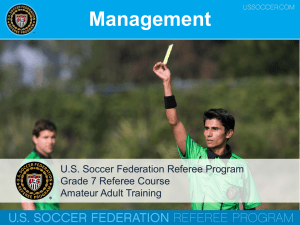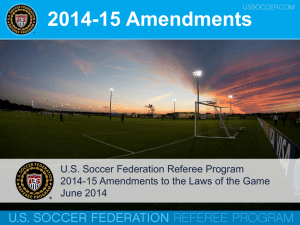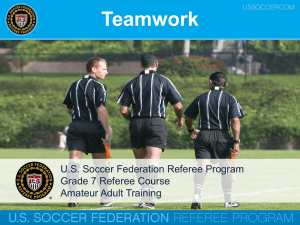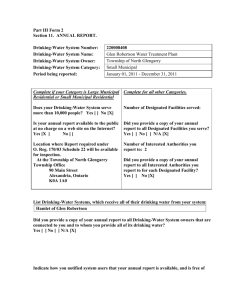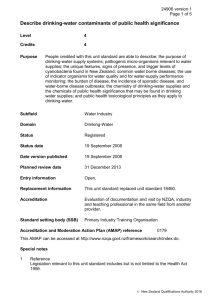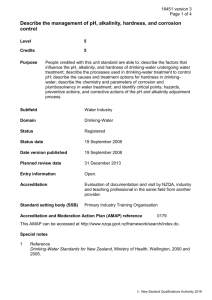The Ministry of Health procedure for approval of new test methods
advertisement
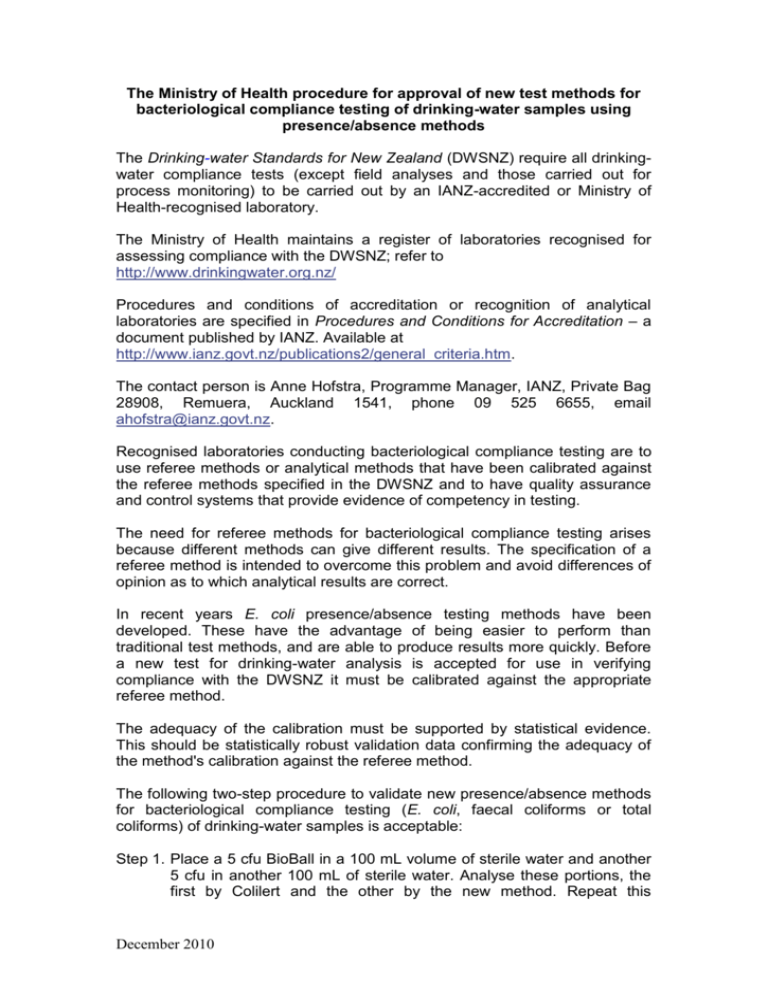
The Ministry of Health procedure for approval of new test methods for bacteriological compliance testing of drinking-water samples using presence/absence methods The Drinking-water Standards for New Zealand (DWSNZ) require all drinkingwater compliance tests (except field analyses and those carried out for process monitoring) to be carried out by an IANZ-accredited or Ministry of Health-recognised laboratory. The Ministry of Health maintains a register of laboratories recognised for assessing compliance with the DWSNZ; refer to http://www.drinkingwater.org.nz/ Procedures and conditions of accreditation or recognition of analytical laboratories are specified in Procedures and Conditions for Accreditation – a document published by IANZ. Available at http://www.ianz.govt.nz/publications2/general_criteria.htm. The contact person is Anne Hofstra, Programme Manager, IANZ, Private Bag 28908, Remuera, Auckland 1541, phone 09 525 6655, email ahofstra@ianz.govt.nz. Recognised laboratories conducting bacteriological compliance testing are to use referee methods or analytical methods that have been calibrated against the referee methods specified in the DWSNZ and to have quality assurance and control systems that provide evidence of competency in testing. The need for referee methods for bacteriological compliance testing arises because different methods can give different results. The specification of a referee method is intended to overcome this problem and avoid differences of opinion as to which analytical results are correct. In recent years E. coli presence/absence testing methods have been developed. These have the advantage of being easier to perform than traditional test methods, and are able to produce results more quickly. Before a new test for drinking-water analysis is accepted for use in verifying compliance with the DWSNZ it must be calibrated against the appropriate referee method. The adequacy of the calibration must be supported by statistical evidence. This should be statistically robust validation data confirming the adequacy of the method's calibration against the referee method. The following two-step procedure to validate new presence/absence methods for bacteriological compliance testing (E. coli, faecal coliforms or total coliforms) of drinking-water samples is acceptable: Step 1. Place a 5 cfu BioBall in a 100 mL volume of sterile water and another 5 cfu in another 100 mL of sterile water. Analyse these portions, the first by Colilert and the other by the new method. Repeat this December 2010 procedure five times. If all of those pairs of tests return “presentpresent” results, the new test has passed the first stage. If not, the new test has failed. Step 2. Seed a 200 mL aliquot of a good quality drinking-water sample with one 5 cfu BioBall and split the sample aliquot equally and proceed as in Step 1. Do this 10 times. If there are fewer than 2 discordant results, the new method will have passed the test. For enumeration data and other details, refer to the NIWA (2007) report to the Ministry of Health ‘Equivalence measures for comparing the performance of alternative methods for the analysis of water quality variables’. For numeric methods, refer to NIWA’s 2007 report to the Ministry of Health: Equivalence measures for comparing the performance of alternative methods for the analysis of water quality variables (PDF, 246 KB) The procedure for obtaining approval of a new presence/absence method for drinking-water compliance testing is summarised below. Details of the new analytical test method, together with a description and results of the validation studies on the method comparing it against the referee method is to be forwarded to the Ministry of Health for assessment. If the Ministry considers the calibration of the new method against the referee method is satisfactory, it will recommend IANZ to include the new analytical test method in the list of methods approved by the Ministry of Health for use by recognised laboratories for drinking-water analysis. In parallel, the approved method will also appear in the Ministry's drinkingwater information base WINZ - a community drinking-water supply information system which is major tool for consistently calculating the compliance of supplies with the DWSNZ, based on monitoring data. December 2010


